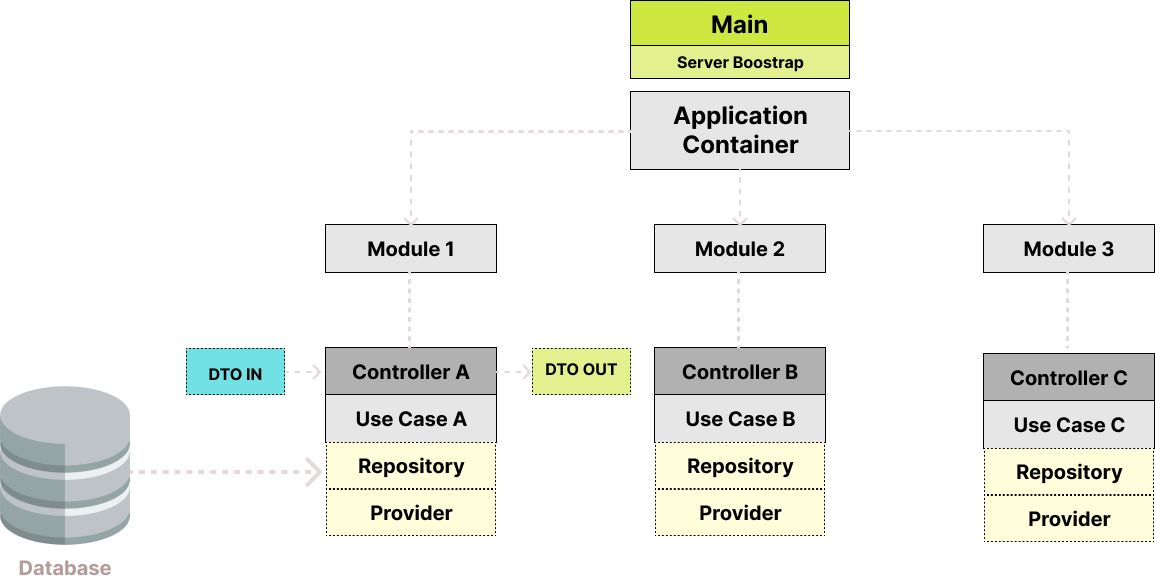First steps
Begin your journey with ExpressoTS! These guides will help you learn and get familiarized with the essential building blocks of ExpressoTS.
Philosophy
ExpressoTS streamlines server-side development by emphasizing clear and structured code. Ideal for both simple APIs and complex systems, ExpressoTS accelerates development and ensures timely, high-quality delivery.
ExpressoTS is a TypeScript framework fully integrated with the Node.js and Expressjs ecosystem. While TypeScript is the primary language, ExpressoTS is fully compatible with JavaScript.
In this tutorial, we’ll use TypeScript for most examples, but feel free to switch to vanilla JavaScript if that suits you better.
Architecture
ExpressoTS architecture centers on the IoC container, which manages dependency injection in class constructors or in properties. This setup ensures that all necessary modules, including routes (controllers), are loaded. Routers then handle incoming requests using use-cases and providers as required.
Here’s an overview of an ExpressoTS application:

- DTO IN/OUT: Defines the structure for incoming and outgoing data.
- Controller: Manages request processing.
- Use Case: Executes specific logic for handling requests.
- Provider: Supplies external functionalities like database access.
- Repository: Handles direct communication with the database.
Pre-requisites
Please make sure that Node.js version >= 20.18.0 is installed on your operating system.
Setup
Install the ExpressoTS CLI globally using NPM to get started with your project setup:
Setting up a new ExpressoTS project is quite simple with ExpressoTS CLI. First install the CLI globally with NPM:
npm i -g @expressots/cli
Create a new project by running:
expressots new project-name
Project templates
ExpressoTS provides two project templates to cater to different development needs:
- Non-opinionated: Provides flexibility in project structure and resource scaffolding, with minimal setup.
- Opinionated: Pre-configured for complex projects, enforcing a specific structure and scaffolding pattern.
- MicroAPI: A minimalistic template for building micro api's.
- Non Opinionated
- Opinionated
- Micro API
Non-opinionated project structure
project-name/
├── src/
│ ├── app.controller.ts
│ ├── app.ts
│ ├── main.ts
├── test/
│ ├── app.controller.spec.ts
| File Name | Description |
|---|---|
| app.controller.ts | A basic controller with a single route. |
| app.ts | Application global configuration file. |
| main.ts | The main entry point of an ExpressoTS application. |
| app.controller.spec.ts | Unit test for the app.controller. |
Opinionated project structure
project-name/
├── src/
│ ├── useCases/
│ │ └── app/
│ │ └── app.controller.ts
│ │ └── app.module.ts
│ │ └── app.usecase.ts
│ ├── app.ts
│ ├── env.ts
│ ├── main.ts
├── test/
│ ├── app.controller.spec.ts
| File Name | Description |
|---|---|
| useCases/* | The use case folder holds the implementation of operations for the application. |
| app.ts | Application global configuration file. |
| env.ts | This is an utility resource that maps .env variables. |
| main.ts | The main entry point of an ExpressoTS application. |
| app.controller.spec.ts | A basic unit test using supertest for the app.controller. |
Micro API project structure
project-name/
├── src/
│ ├── api.ts
├── test/
│ ├── api.spec.ts
| File Name | Description |
|---|---|
| api.ts | The main entry point of an ExpressoTS application. |
| api.spec.ts | A basic unit test for the app controller. |
Opinionated projects have a different scaffold pattern in addition to the non-opinionated projects. They are pre-configured for complex projects, enforcing a specific structure and name convention.
Main entry point
The main entry point main.ts or api.ts of an ExpressoTS application is where the application is initialized. This file is responsible for bootstrapping
the application and starting the server.
- Non Opinionated
- Opinionated
- Micro API
AppFactory.create(App).then((app) => app.listen(3000));
AppFactory.create(App).then((app) =>
app.listen(env.App.Port, {
appName: env.App.appName,
appVersion: env.App.appVersion,
})
);
const microAPI = createMicroAPI();
microAPI.setGlobalRoutePrefix("/v1");
const app = microAPI.build();
app.Middleware.addBodyParser();
app.Route.get("/", (req: Request, res: Response) => {
res.send("Hello from ExpressoTS!");
});
app.listen(3001);
bootstrap();
The AppFactory class is responsible for creating the application instance. The AppFactory was designed to support multiple web servers like Express.js, Fastify, and more. Currently, it only supports Express.js.
- The
createmethod accepts the application class as parameters (app.ts). - The
listenmethod starts the server on the specified port with default environment settings. You can also pass an object specifying the app's name and version.
The App class is the application root module, which is responsible for initializing the application and its dependencies.
All application configuration and setup are handled in the App class - (app.ts) file.
The application environment is defined by a method called initEnvironment("development"). You can also specify the .env file path as a parameter for each environment.
initEnvironment("development", {
env: {
development: ".env.development",
production: ".env.production",
},
});
MicroAPI project have the entire application setup in the api.ts file. The createMicroAPI function is responsible for creating the application instance.
Running the application
With your application set up, you can start your development server, build your application, or run it in production mode.
Development mode
✔️ npm run dev
Build the application
✔️ npm run build
Production mode
✔️ npm run prod
Once the application is up and running, you can access it by navigating to http://localhost:3000/.
You should see Hello from ExpressoTS! displayed on the screen.
Linter and formatter
ExpressoTS uses ESLint and Prettier to enforce code quality and consistency. You can run the following commands to lint and format your code:
✔️ npm run lint
✔️ npm run format
Testing
ExpressoTS uses Jest as the testing framework. You can run the following command to execute your tests:
✔️ npm run test
Support us ❤️
ExpressoTS is an MIT-licensed open source project. It's an independent project with ongoing development made possible thanks to your support. If you'd like to help, please read our support guide.